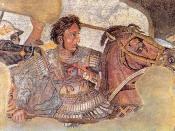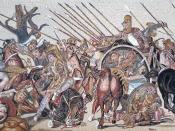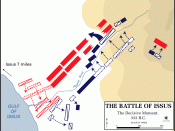Alexander the Great was born in Pella, the ancient capital of Macedonia, a kingdom north of Hellas (Greece), in 356 BC. He was the son of Phillip II, king of Macedonia, and of Olympias. Olympias was the princess of Epirus. At the age of 13, Aristotle gave Alexander a thorough training in rhetoric and literature and stimulated his interest in science, medicine, and philosophy. Alexander was handsome and had the physique of an athlete. He excelled in hunting and loved riding his horse Bucephalus. His chief interest was military strategy. Alexander was inspired by the feats of the warriors in Homer's Iliad and always kept a copy of the epic poem under his pillow. In the summer of 336 BC, Philip II was assassinated. Alexander, at the age of 20, came to the Macedonian throne and became the king of Macedonia. Alexander's mother, Olympias, most likely plotted his death.1 Soon, he started defeating huge armies and huge empires such as the Persian Empire as well as uniting his own empire.
He won all his battles including the battle of Issus, which was a big victory for him. He kept gaining new territory. He was extremely intelligent and sometimes extremely cruel.2 Alexander the Great was the greatest military strategist and leader in ancient history because of his brilliant decisions-which included many deceptions and maneuvers, his use of the Macedonian phalanx and his undefeated battle record that includes defeating armies many times larger than his army; however, his cruelty and occasional unjust judgments would have led to his assassination had he not died suddenly at the age of 33 of a fever.
The Macedonian phalanx was a key to Alexander the Great's great success. The Macedonian phalanx is an infantry formation developed by Philip II and used by his son Alexander the Great to conquer the Persian Empire. King Philip transformed the original Greek phalanx into a devastating and awesome formation, the Macedonian phalanx. The phalanx was a flexible unit well drilled and able to take on a variety of formations. It was a box formation for infantry soldiers from 8 to 36 men deep. It was usually 16 men on a side, 256 men in each unit, always and exclusively Macedonian.3 Alexander was the one who exploited it. He used this in almost all his battles, as it was very useful. The phalanx helped Alexander win many of his great battles. Without it, Alexander wouldn't have been so successful in battle. Some of the soldiers in the phalanx were armed with sarissa. The sarisa measured 13 up to 24 feet. It would arose lots of fear in the enemies. The sarissas were carried in two pieces, slid together just before battle, and had to be wielded with two hands. Since they were in pieces, it was easier for Alexander's army to carry them.4 At close range such large weapons were useless, but an intact phalanx could easily keep its enemies at a distance; the weapons of the first five rows of men all projected beyond the front of the formation, so that there were more spear points than available targets at any given time. The men in the front carried spears of about four to six meters (12 to 18 feet) that were usually held in an upright position. When held vertically, the wall of spears helped hide what was going on with the units behind the formation. When held horizontally, enemies could be killed at a safe range from the formation; this helped Alexander defeat his enemies.5 The phalanx was revolutionary for its time and was a very potent weapon. It was only surpassed when the Romans developed the legion, another infantry formation with different weapons and armor. The phalanx was well suited for a defensive role during battles. Because it lacked tactical flexibility, the phalanx was a better defensive than offensive formation. It formed the center of the front and capable of stopping just about any enemy attack. Using the phalanx, Alexander stopped many attacks. Because its effectiveness relied entirely on cohesion, an attacking or advancing phalanx could run into serious trouble, especially on rough or hilly ground.6At the battle of Issus, the steep banks of the river prevented Alexander's attacking phalanx from keeping a regular and unbroken front, resulting in serious numbers of casualties. The prime weapon of the advancing phalanx was the fear it inspired and the demoralizing effect it had on the enemy. Phalanxes remained dominant on battlefields throughout the Hellenistic period. Phalangites were professional soldiers, and were among the first troops ever to be drilled, thereby allowing them to execute complex maneuvers well beyond the reach of most other armies. The real strength of the phalanx was its many formations and maneuvers. While the square was the usual formation, it could form a line or wedge or other shapes. The soldiers were trained to respond to flag and trumpet signals. They fought packed in a close rectangular formation, typically eight men deep, with a leader at the head of each column and a secondary leader in the middle, so that the back rows could move off to the sides if more frontage was needed. Unlike earlier hoplites, phalangites didn't have shields except possibly those of the first row who carried only tiny shields. No enemies were expected to get close enough for them to need any.7 The phalanx was a big part of Alexander's key to success. In every battle, he used this formation in order to win the battle. The other armies didn't use the phalanx; therefore when they saw it in Alexander's army, they got scared. That fear caused his enemies to not fight so good, which helped Alexander win the battle. 8Alexander the Great had an undefeated battle record, which includes defeating armies much larger than his. The battle of Issus was considered a great victory to Alexander. He was considerably outnumbered and his men were very tired. Alexander won the battle, but it was not a decisive victory for him. The battle was not fought at Issus, it was fought on the Pinarus River on the south-eastern coast of the Mediterranean Sea.9 The battle was between Alexander and Darius, the Persian general. The Persians had 600,000 men and Alexander only had 75,000. Alexander held back a reserve force, the first time it had ever been done in history. In all, 124,950 soldiers died during the battle, 110,000 Persians, 450 Macedonians died and 4500 were wounded, and 10,000 Greek mercenaries. Darius and the Persians allied with Greek mercenaries, and the Kardakes. The Kardakes were allies of the Persians. Alexander and the Macedonians allied with the Thessalians, and the Agrianes.10Alexander made brilliant decisions, deceptions, and maneuvers during the battle of Issus. The beginning of the battle is the opening maneuvers, before any actual fighting takes place. First, Darius entered Issus in late October or early November, 333 BC. Alexander had taken his men on a forced march to Myriandrus, thinking this was where Darius was going. Alexander had left all of his sick and wounded soldiers at Issus. When Darius got to Issus, he killed all of Alexander's hospital cases. Darius learned of Alexander's position and took his troops to the Pinarus and took a defensive position on the northern bank, right along Alexander's line of communication. Once Alexander learned of Darius' position, he gave a rousing speech to his men and positioned his men for battle. Alexander put his cavalry, the Thessalians, allies of the Macedonians, and his Macedonians on the right, and other allies on the left. Darius stationed 30,000 Greek mercenaries against the Macedonian phalanx and on either side 60,000 Kardakes, who were allies of the Persians, he also put 20,000 men on the ridge to face Alexander's right. Darius was in the center of his army behind the Royal Bodyguard. Darius moved all of his best troops against Alexander's left, so Alexander moved the Thessalians to the left as reinforcements. Both armies deployed, but the Macedonian army stopped when they got to within arrow shot of the Persians, hoping they would attack, but Darius had a good defensive position, and was not leaving it. Alexander had already started making complex maneuvers and decisions.11Most of Alexander's intelligent decisions come into use in the middle of the battle. The fighting starts in the middle of the battle. The middle is where the Macedonians and the Persians jockey for position, before the battle is decided. In the middle of the battle, Alexander had thrown out his right wing in advance at the Persian left-center, right where Darius was stationed. The Persian left gave way very quickly, a quick victory for the Macedonians. The Macedonian phalanx had lost its solidarity while crossing the Pinarus. A gap opened in the right flank of the Macedonian phalanx and the Greek mercenaries took advantage, driving a deep wedge into the Macedonian line. Alexander swung his cavalry around against the rear files of the mercenaries.12Alexander beat an army that is almost seven times larger than his. Jockeying for position has taken place and Alexander was about to come out on top. Alexander's battalions went to help out in the center. The Persian cavalry would not give way, but attacked the Thessalian squadrons. During this time, Darius took flight and the Persian army soon gave way without its leader. Only the Greek mercenaries stood their ground, dying as they were attacked from all sides. The Persians suffered their heaviest loses in retreat. The Macedonian army and Alexander took off after Darius, but couldn't catch him; he had a half-mile head start. Alexander won this battle.13 After reading the description of the Battle of Issus, one can conclude that Alexander made brilliant decisions, which includes his many deceptions as well as complex battle maneuvers.
Alexander's order of battle was very impressive. He was an expert at organizing his units for complex battle maneuvers, hiding the true numbers that make up of his forces, and managing his army during the flow of the battle. He made many deceptions to his enemies. For example, in the battle of Issus, Alexander had about 75,000 men and the Persians had about 600,000 men, but the Persians didn't know that. He made them think that he had more men then they did through a series of complex tactics. That way he put fear into the enemies. Alexander would sometimes send forces from unexpected places to fight the enemies. The enemies wouldn't know where Alexander's forces would come from.14 The phalanx that he used contributed in awakening fear in his enemies. He made intelligent decisions on how to control his forces and on how to make intelligent deceptions. He was noted for his brilliance as a tactician and troop leader and for the rapidity with which he could traverse great expanses of territory. During the battle of Issus, Alexander hid the true numbers that made up his forces. He never let the Persians find out exactly how many men he had. He did that by arranging his armies different ways.That deception helped him win the battle.15 His decisions, deceptions, maneuvers, and tricks helped make him a great military leader and strategist in ancient times.
Alexander had an undefeated battle record. He fought countless battles across Asia, but didn't lose a single battle. No matter how large or small the enemy forces are he defeated them. There was no stopping him. He kept gaining new territory. If he hadn't died, he would have conquered the known world. Alexander beat armies 7-10 times larger than his, which is truly incredible!16However, Alexander The Great's cruelty and occasional unjust judgments would have led to his assassination had he not died suddenly at the age of 33 of a fever. He was usually brave and generous, but could be cruel and ruthless when politics demanded. The theory has been advanced that he was actually an alcoholic having, for example, killed his friend Clitus in a drunken fury. He sold innocent people as slaves, often for no reason or for fun. Sometimes when Alexander got drunk or became mad, he killed innocent people and ordered executions. For example, once in a drunken fury, he ordered executions of a group of people for no reason at all. That group was laughing and Alexander thought, they were laughing at him. So, he executed them. After his actions, he usually regretted his actions deeply, but that is of no use. What is done is done.17 There was a famous saying in the time of Julius Caesar, which was "The die is cast." It means what has been done is done; there is no changing or going back, which relates to Alexander's scenario. All that certainly means that Alexander could be extremely cruel.
When he won a war, he often raped and murdered the prisoners and the people of the territories that he conquered. He also tortured people to death. For example, one time he had a doubt that one person was planning something against him even though he wasn't. So Alexander tortured that person till death. That person was badly wiped, burnt, and tortured till death. He never stopped being cruel.18 This alone would have led to his assassination had he not died of a fever at age 33. Even though Alexander was a great military leader and strategist, he definitely was very cruel and unjust at times.19It clearly appears Alexander the Great was the greatest military strategist and leader in ancient history. He made brilliant decisions, deceptions and maneuvers. Alexander's key to success was his use of the Macedonian phalanx. The Macedonian phalanx, an infantry formation, helped Alexander win many battles. During the battle of Issus, he beat an army almost 7-10 times bigger than his due to his tactics and strategies. He had an undefeated battle record that includes defeating armies many times larger than his army. I predict that his cruelty and unjust judgments would have led to his assassination had he not died suddenly at the age of 33 of a fever.
Footnotes / Endnotes1. Holt, Rinehart and Winston, World History - People & Nations, USA; 2000, pp #192. Badian, E, Grolier Multimedia Encyclopedia - Alexander The Great, Badian, E; 20003. Author not mentioned, Encarta Encyclopedia - Alexander The Great, USA; 20004. Hackney, Adam, http://www.hackneys.com/alex_web, 19975. Hackney & Badian6. Hackney7. Badian8. Popovic, John J, http://1stmuse.com/frames/index.html, 19969. Cox, A, http://www.richeast.org/htwm/Greeks/Issus/Issus.html, 200010. Author not mentioned, Compton's Encyclopedia - Battle Of Issus, 200011. Cox12. Hackney13. Cox14. Popovic15. Badian16. Hackney17. Badian & Hackney18. Popovic19. HackneyApproximate Word count = 2389Approximate Pages = 9.6(250 words per page double spaced)


